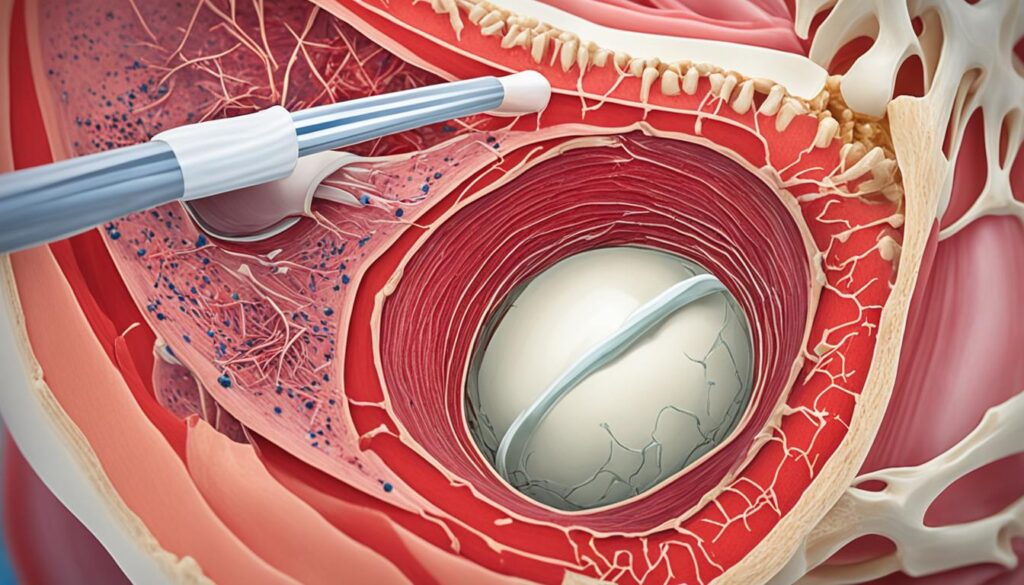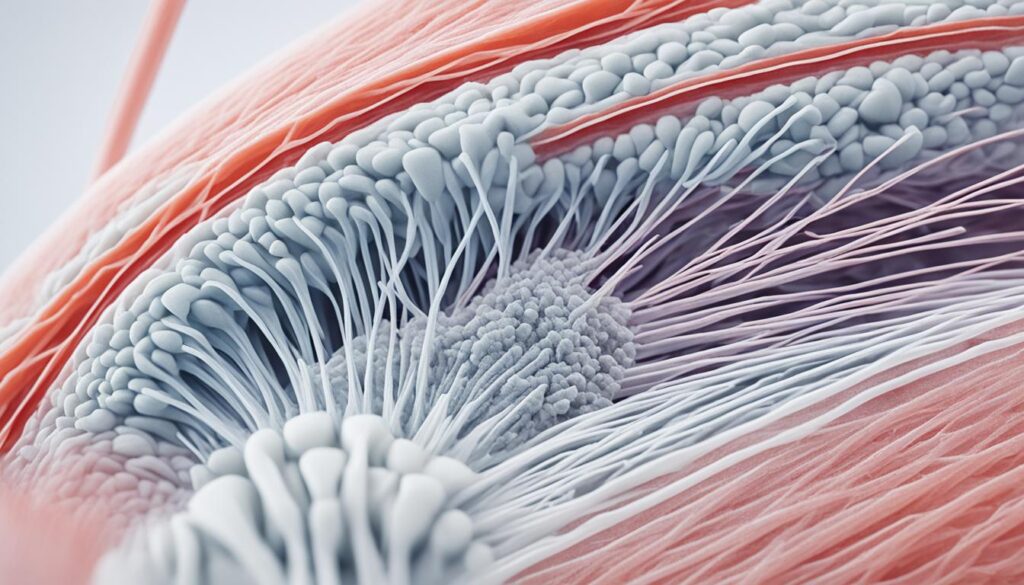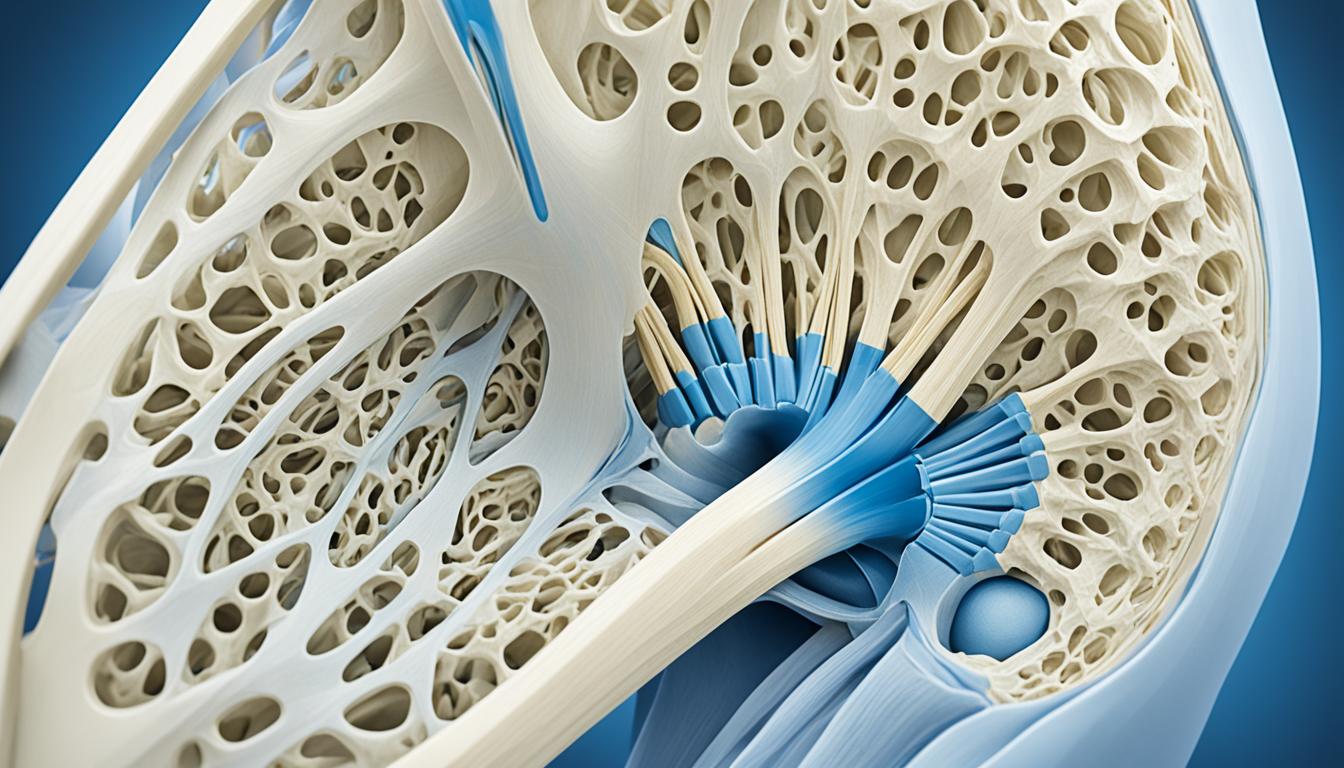Did you know that patellar tendon injuries account for up to 40% of all knee injuries?
The patella tendon, also known as the patellar tendon, is a crucial connector that links the muscles in the front of your thigh to your shinbone. It plays a vital role in straightening your leg and is essential for everyday activities like walking and running. However, when the patella tendon is injured, it can significantly impact your mobility and quality of life.
Patellar tendon injuries, such as patellar tendonitis or a tear, can result in intense pain, difficulty in walking, and even the need for surgery and rehabilitation. These injuries can occur due to various factors, including falls, jumping, tendon weakness, chronic diseases, and certain medications.
As experts in patellar tendon injuries, we understand the importance of recognizing the symptoms, understanding the causes, and exploring the correct treatment options. In this article, we will take an in-depth look at the patella tendon, its anatomy, the signs of injuries, diagnosis methods, treatment options, and preventive measures.
Symptoms and Diagnosis of Patellar Tendon Tears
The primary symptom of a patellar tendon tear is knee pain, usually felt between the kneecap and the shinbone. Initially, the pain may only occur during physical activity or after intense workouts, but it can worsen over time and interfere with sports and daily movements.
To diagnose a patellar tendon tear, doctors rely on a detailed medical history and a thorough physical examination. During the examination, they may perform the knee extension test to assess the ability to straighten the knee. Imaging tests like X-rays and MRIs may be ordered to confirm the diagnosis and evaluate the extent of the tear.
Common Symptoms of Patellar Tendon Tears:
- Knee pain, especially between the kneecap and the shinbone
- Difficulty straightening the knee
- Swelling and tenderness around the patellar tendon
- Weakness or instability in the knee
It’s important to seek medical attention if you experience persistent knee pain or suspect a patellar tendon tear. Early diagnosis and treatment can prevent further damage and improve recovery outcomes.
| Physical Examination | Imaging Tests |
|---|---|
| Doctors will perform a physical examination to assess the knee’s range of motion, stability, and signs of inflammation. They may also palpate the area to identify local tenderness and swelling. | The two most commonly used imaging tests for diagnosing patellar tendon tears are X-rays and MRIs. X-rays can help identify any associated fractures or abnormalities in the knee structure. MRIs provide detailed images of the soft tissues, allowing doctors to assess the extent of the tear. |
By accurately diagnosing patellar tendon tears through a combination of medical history, physical examination, and imaging tests, doctors can recommend the most appropriate treatment plan tailored to the individual’s condition.

Causes and Risk Factors for Patellar Tendon Tears
Patellar tendon tears are commonly caused by repetitive mechanical stress on the knee extensor tendons. This overuse injury leads to small tears in the patellar tendon, resulting in pain and functional limitations. This condition is often referred to as patellar tendinopathy or jumper’s knee, as it is frequently seen in athletes involved in sports that require frequent jumping, such as basketball and volleyball.
Several risk factors contribute to the development of patellar tendon tears. Physical activities that place excessive stress on the tendon, such as repetitive jumping or running, can increase the risk. Additionally, having tight leg muscles and a muscular imbalance between the quadriceps and hamstring muscles can predispose individuals to patellar tendon tears.
Other risk factors include chronic illnesses that affect blood supply to the knee, such as diabetes or rheumatoid arthritis. Certain medications, such as corticosteroids or anabolic steroids, can also weaken the tendons and make them more susceptible to tears.
Potential Causes of Patellar Tendon Tears:
- Repetitive mechanical stress on the knee extensor tendons
- Tight leg muscles and muscular imbalance
- Chronic illnesses affecting blood supply to the knee
- Medications, including corticosteroids and anabolic steroids
Understanding these causes and risk factors is crucial in preventing patellar tendon tears. By implementing appropriate training techniques, performing proper warm-up exercises, and maintaining a balance in muscle strength, individuals can reduce the risk of developing this debilitating injury.

By taking proactive measures and addressing the underlying risk factors, individuals can minimize the occurrence of patellar tendon tears and maintain optimal knee health.
Treatment Options for Patellar Tendon Tears
When it comes to treating patellar tendon tears, the options available depend on the severity and extent of the injury. Non-surgical treatment approaches are typically recommended for small, partial tears. These methods aim to provide pain relief, promote healing, and restore knee function.
Non-Surgical Treatment
For small tears, immobilization with a knee brace can help protect the tendon and allow it to heal. The brace provides stability and support while decreasing stress on the tendon. Additionally, physical therapy plays a crucial role in non-surgical treatment. It focuses on strengthening the surrounding muscles and restoring range of motion in the knee. Physical therapy includes exercises that target the quadriceps and hamstrings to maintain knee stability and promote healing.
A comprehensive approach to non-surgical treatment can effectively manage small patellar tendon tears, improving pain and functionality while avoiding the need for surgery.
Surgical Treatment
In cases of complete tears or chronic, refractory patellar tendon tears, surgical treatment is often necessary to reattach the torn tendon to the kneecap and restore knee function. The surgical procedure involves suturing or using suture anchors to secure the tendon to the bone. In some cases, additional measures such as wires, sutures, or cables may be employed to provide extra protection to the repair. The procedure can typically be performed on an outpatient basis, but depending on the individual case, a hospital stay may be required for closer monitoring and post-surgery care.
Surgical treatment is typically reserved for more severe cases of patellar tendon tears, providing a more direct and stable repair to restore proper knee function.
To further illustrate the treatment options for patellar tendon tears, below is a table summarizing the key features of non-surgical and surgical treatments:
| Non-Surgical Treatment | Surgical Treatment |
|---|---|
| Immobilization with a knee brace | Tendon reattachment |
| Physical therapy to strengthen muscles and restore range of motion | Use of sutures or suture anchors |
| Natural healing process | Addition of wires, sutures, or cables for extra protection |
Please note that the specific treatment plan should be determined by a healthcare professional after a thorough evaluation of the individual’s condition.
As with any medical procedure, there are potential risks and benefits associated with each treatment option. It is crucial for patients to have a detailed discussion with their healthcare provider to fully understand the potential outcomes and make an informed decision regarding their treatment plan.
Complications and Prevention of Patellar Tendon Tears
When patellar tendon tears occur, complications can arise, leading to weakened knee function and limited range of motion. Common complications include:
- Weakness: A patellar tendon tear can cause significant weakness in the affected leg, making it difficult to perform everyday activities and engage in sports.
- Loss of motion: In addition to weakness, a tear in the patellar tendon can result in a reduced range of motion in the knee joint, limiting the ability to fully extend or bend the leg.
- Re-tears: In some cases, even after surgical repair, there is a risk of re-tearing the patellar tendon, which may require further intervention and prolong the recovery process.
- Detachment of the repaired tendon: In rare cases, the repaired tendon may become detached from the bone, necessitating revision surgery to reattach it.
To minimize these complications and achieve optimal recovery, it is crucial to follow the recommended rehabilitation and strengthening exercises post-surgery. These exercises are designed to gradually rebuild the strength and flexibility of the patellar tendon and surrounding muscles, helping to restore normal knee function. Physical therapy plays a vital role in guiding patients through these exercises and monitoring progress.
Prevention is always better than cure when it comes to patellar tendon tears. To reduce the risk of injury, it is essential to avoid playing through pain and to listen to your body. If you experience persistent knee pain, it is important to seek medical attention and refrain from activities that put excessive stress on the patellar tendon.
Additionally, incorporating specific strengthening exercises into your workout routine can help improve the stability and resilience of the patellar tendon. These exercises typically target the quadriceps and hamstring muscles, as well as the hip muscles, which play a supportive role in knee function. Working with a qualified fitness professional or physical therapist can ensure that you perform these exercises correctly and safely.
| Complications of Patellar Tendon Tears | Prevention Strategies |
|---|---|
| Weakness | Follow post-surgery rehabilitation and strengthening exercises |
| Loss of motion | Listen to your body and avoid activities that exacerbate pain |
| Re-tears | Seek medical attention for persistent knee pain and refrain from high-risk activities |
| Detachment of the repaired tendon | Work with a qualified fitness professional or physical therapist to perform proper strengthening exercises |
Patellar Tendinopathy Overview
Patellar tendinopathy, also known as jumper’s knee, is a painful condition that commonly affects athletes involved in jumping sports. It is caused by small tears in the patellar tendon due to overuse and repetitive stress. The main symptom of patellar tendinopathy is localized pain and tenderness on the inferior tip of the patella.
The patellar tendon plays a crucial role in knee stability and function. It connects the quadriceps muscles in the thigh to the shinbone. However, continuous jumping and landing can lead to excessive strain and micro-tears in the tendon, causing pain and inflammation.
Physical therapy is often the first line of treatment for patellar tendinopathy. It focuses on stretching and strengthening the muscles around the knee to relieve pain and improve function. A comprehensive rehabilitation program may include exercises such as eccentric strengthening, isometric exercises, and balance training.
Patellar tendinopathy requires a multifaceted approach to management. Physical therapy is essential for restoring strength, flexibility, and function to the knee. Self-care measures are equally important in managing symptoms and preventing further injury.
Self-care measures for patellar tendinopathy include:
- Applying ice to the affected area to reduce pain and inflammation.
- Modifying activities that aggravate symptoms, such as reducing jumping and performing low-impact exercises.
- Wearing appropriate footwear with good shock absorption to minimize stress on the tendon.
- Using patellar tendon straps or braces to provide additional support and relieve pressure on the tendon during physical activities.
Prevention of Patellar Tendinopathy
Preventing patellar tendinopathy involves taking proactive steps to minimize the risk of injury. It is important to gradually increase the intensity and duration of physical activity, allowing the body to adapt to the demands placed on the tendon. Strengthening exercises that target the quadriceps and hamstring muscles can also help improve knee stability and prevent excessive strain on the patellar tendon.
Symptoms of Patellar Tendinopathy
Common symptoms of patellar tendinopathy include:
- Localized pain and tenderness below the kneecap.
- Pain during activities that involve jumping or forceful knee extension, such as running and jumping sports.
- Stiffness and limited range of motion in the knee.
It is important to seek medical attention if these symptoms persist or worsen over time. An accurate diagnosis and appropriate treatment can help manage patellar tendinopathy effectively and prevent long-term complications.
Conclusion
The patella tendon is a critical component of our knee function and overall knee health. Understanding the causes, symptoms, diagnosis, treatment options, complications, and prevention strategies for patellar tendon tears and tendinopathy is essential, especially for athletes and individuals who frequently engage in activities that put stress on the tendon.
By taking preventive measures, such as avoiding overuse and implementing targeted strengthening exercises for the thigh muscles, we can significantly reduce the risk of patellar tendon injuries and ensure optimal knee health. It is crucial to prioritize our knee’s well-being by listening to our bodies, avoiding excessive strain on the patella tendon, and incorporating proper warm-up and cooldown routines into our physical activities.
In the event of a patellar tendon injury, proper diagnosis and timely treatment are essential for successful recovery and a return to normal functioning. Seeking medical attention, following the recommended treatment plan, and diligently participating in rehabilitation exercises are key steps towards a full recovery and the restoration of knee strength and mobility.
Remember, our knee health is in our hands. By prioritizing prevention, understanding the importance of the patella tendon, and taking proactive steps to protect it, we can enjoy an active and pain-free lifestyle while keeping our knees strong and resilient.
FAQ
Why is the patella tendon important?
The patella tendon is a strong fibrous tissue that connects the muscles in the front of your thigh to your shinbone, playing a critical role in straightening your leg.
What are the symptoms and how are patellar tendon tears diagnosed?
The primary symptom of a patellar tendon tear is knee pain, usually felt between the kneecap and the shinbone. To diagnose a patellar tendon tear, doctors rely on a detailed medical history, a thorough physical examination, and imaging tests like X-rays and MRIs.
What causes patellar tendon tears and what are the risk factors?
Patellar tendon tears are primarily caused by repetitive mechanical stress and are common in sports that involve frequent jumping. Risk factors include physical activity that puts stress on the tendon, tight leg muscles, muscular imbalance, chronic illnesses, and certain medications.
What are the treatment options for patellar tendon tears?
The treatment for patellar tendon tears depends on the severity and extent of the tear. Non-surgical approaches like immobilization and physical therapy are recommended for small, partial tears, while surgical repair is often necessary for complete tears or chronic cases.
What are the complications of patellar tendon tears and how can they be prevented?
Complications of patellar tendon tears include weakness, loss of motion, re-tears, and detachment of the repaired tendon. Following recommended rehabilitation and strengthening exercises post-surgery can minimize these complications. Preventive measures include avoiding activities that put stress on the tendon and strengthening the thigh muscles.
What is patellar tendinopathy and how is it treated?
Patellar tendinopathy, also known as jumper’s knee, is a painful condition caused by small tears in the patellar tendon due to overuse. Treatment usually begins with physical therapy to stretch and strengthen the muscles around the knee, along with self-care measures such as icing the area and reducing or avoiding activities that trigger symptoms.
Why is understanding the patella tendon important and what are some prevention tips?
Understanding the causes, symptoms, diagnosis, treatment options, complications, and prevention strategies for patellar tendon tears and tendinopathy is crucial for athletes and individuals who engage in activities that stress the tendon. Prevention tips include avoiding overuse, implementing strengthening exercises, and improving technique with professional instructions.

Leave a Reply